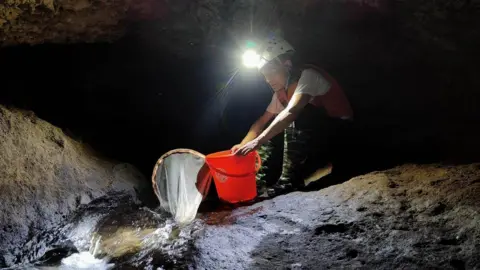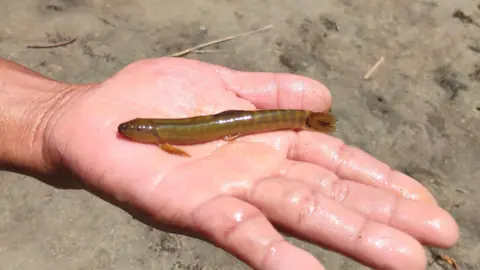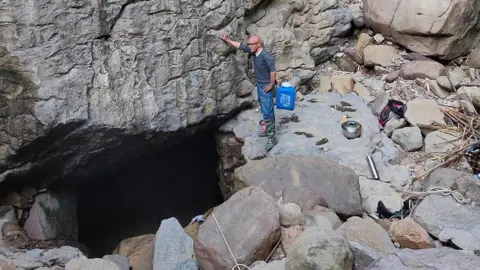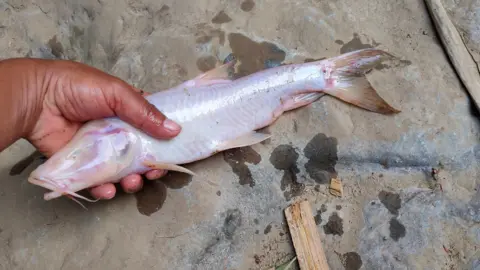Inside the fascinating world of India's blind cave-dwelling fish
 Gauhati University, Department of Zoology
Gauhati University, Department of ZoologyTwo years ago, zoologist Khlur Baiaineh Mukhim spotted something intriguing in a stream in a remote underground cave in India's north-eastern Meghalaya state.
It was a fish he had never seen before, with long barbels - the whisker-like protrusion around a fish's mouth - yellowish-green in colour and, most importantly, with eyes.
Cave-dwelling fish, or species of fish that live exclusively in caves, usually don't have eyes, as they have adapted to living in darkness, which is why the fish Mr Mukhim spotted stood out to him.
Researchers in Meghalaya now say it is a brand new species of fish, one that has adapted to living above as well as under the ground - a unique characteristic among cave-dwelling species.
Their findings were published earlier this month in the latest issue of the Journal of Fish Biology, a leading peer-reviewed publication on fish research.
 Khlur Baiaineh Mukhim
Khlur Baiaineh MukhimThe researchers have named the fish Schistura 'densiclava' after the thick black stripe on its tail.
They say that the species is endemic to the cave it was discovered in - Krem Mawjymbuin - in the eastern Khasi Hills, and has been found to exist in both water pools 60m (196ft) deep inside the cave, as well as a nearby stream above ground.
Dandadhar Sarma, a professor of zoology and one of the researchers of the study, says that the environment inside the cave is harsh, where temperatures drop to 18C (64.4F) - the ideal temperature for tropical fish to survive is much higher - and oxygen levels are extremely low.
"So it's remarkable that the fish can adapt to both - harsh subterranean conditions as well as more favourable surface conditions," Mr Sarma says.
Schistura densiclava is the sixth cave-dwelling species of fish that has been discovered in Meghalaya over the past two to three decades, but the only one which has been found to show this ability to adapt to two very different kinds of environments.
The state is known to have some of the most complex cave systems in the world but many of its estimated 1,500 to 1,700 limestone and sandstone caves remain unexplored, as they are located in remote, forested regions that are challenging to access.
These cave networks are home to numerous animal species that display fascinating evolutionary characteristics but they remain largely unknown because of insufficient research, Mr Sarma says.
Over the past five years, a team of researchers from the state, funded by the federal government, have been systematically exploring Meghalaya's vast network of caves to locate and document new species of fish living inside them.
In 2019, the research team discovered Neolissochilus pnar, the largest cave-dwelling fish species in the world, Mr Sarma says.
The fish was found inside the Krem Umladaw cave in the western Jaintia Hills in a deep pond hundreds of metres below the ground.
 Khlur Baiaineh Mukhim
Khlur Baiaineh MukhimMr Mukhim, who is part of the team and has undertaken dozens of cave expeditions, says that cave-dwelling fish display evolutionary traits that are as fascinating as the those displayed by animals living at the Earth's poles or deep inside its oceans.
"Cave ecosystems are one of the harshest environments to live in," he says.
"These fish usually live in perpetual darkness, stagnant, shallow water pools with dangerously low oxygen levels and sometimes, go for months with little to no food."
Nature has helped them survive by doing away with the unwanted and strengthening what's necessary for survival.
Consequently, they've lost their eyesight and ability to produce colourful pigments, which would otherwise be a needless waste of energy inside a pitch-dark cave.
Instead, they have a sharper sense of taste and smell, and sensory organs on their skin help them detect vibrations to navigate the substrate and avoid predators.
Their sources of food include only what's available inside the cave, like leaf debris and marine organisms flushed in by seasonal floods, and even bat excreta.
And within this extremely harsh environment, these cave-dwelling fish species live out their lives, some living up to a decade, and even produce offspring.
Remarkably, their offspring are born with eyesight - a feature that links them to the surface-dwelling ancestors from which they've evolved - and gradually, they lose their eyesight as they age.
 Khlur Baiaineh Mukhim
Khlur Baiaineh MukhimBut searching for these fish is no easy task.
It involves rappelling down hundreds of metres into cavernous holes in the earth, squeezing through tiny tunnels with little oxygen and wading through pools filled with creatures yet unknown in pitch darkness.
"Our headlights are the only source of light," Mr Mukhim says.
Catching fish involves squatting near pools for hours, and swiftly sweeping up the skittish creatures in a net as they present themselves.
Mr Mukhim, who has been studying fish found in the caves of Meghalaya for over a decade, says that there's a need to study these species as that is the only way we will be able to conserve them.
"Once a species is wiped out, you can never bring them back," Mr Mukhim says.
"It's painful to think that an entire ecosystem in our midst, one of the most fascinating ones, has been studied so little," he adds.
"It's time we paid a little more attention to these cave-dwelling marvels of nature."
Follow BBC News India on Instagram, YouTube, Twitter and Facebook.
